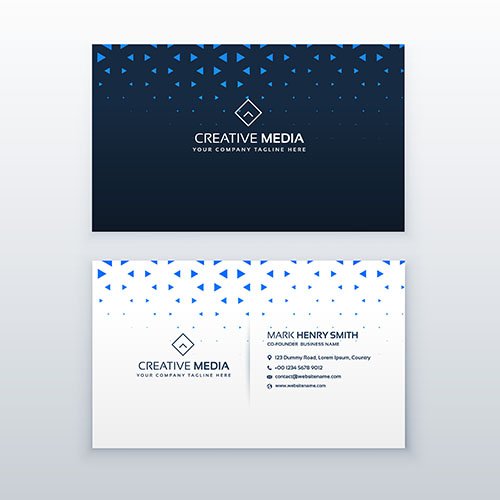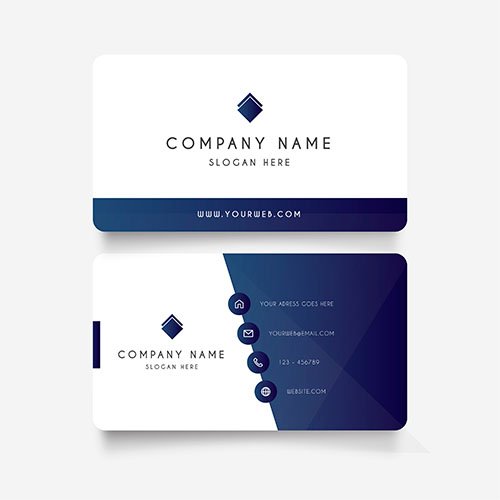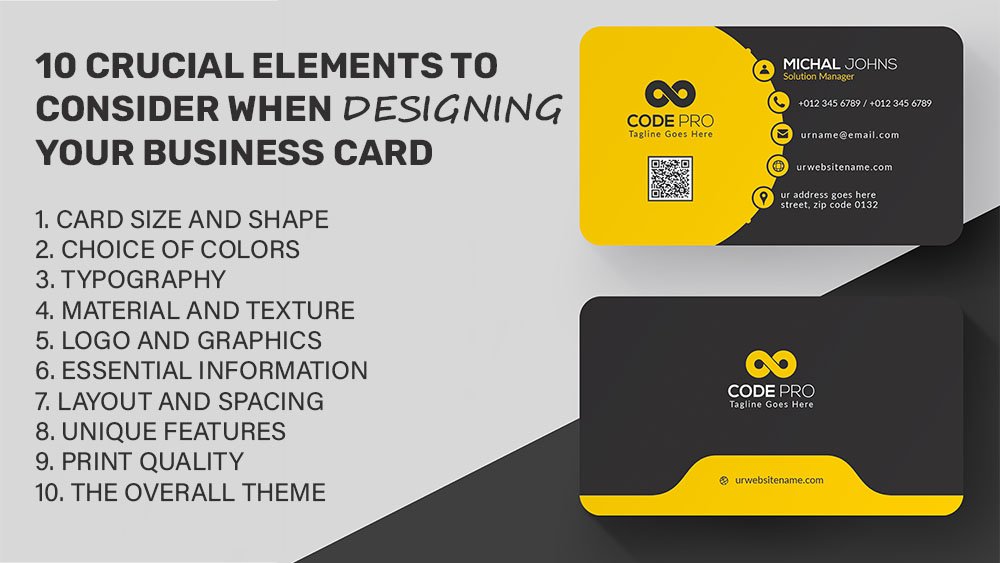I. Introduction
We live in a world driven by digital encounters, yet nothing can replace the tangible impact of a well-designed business card. Acting as your brand’s miniature ambassador, it leaves an enduring mark on your client’s minds.
II. The Importance of Business Card Design
A well-crafted business card is far more than just a piece of paper with your contact details. It acts as a physical representation of your brand’s message and identity.
A. The Role of Business Cards in Today’s Business World
In spite of the surge in digital communication, the importance of a tangible business card can’t be underestimated. As of 2023, a staggering 10 billion business cards are printed annually in the US alone, demonstrating their critical role in business networking. The business card serves as a personal touchpoint in an increasingly digital landscape, creating a unique, memorable connection between you and your potential client.
B. How a Business Card Reflects Your Brand Identity
Your business card is not just a tool for sharing your contact information; it’s an extension of your brand. It can tell a story about your company, reflecting your company culture and values. For instance, a sleek, minimalist card may speak volumes about a company’s focus on simplicity and clarity, whereas a bright, visually loaded card may suggest a creative, innovative approach.

Business Cards
C. Business Cards as Marketing Tools
In addition to providing contact details, a business card is a powerful marketing tool. By using thoughtful design, unique features, and high-quality printing, your card can capture attention and leave a lasting impression, making it more likely for a person to follow up or share your card with others.
D. The Business Card in a Global Context
Your business card can also serve as a symbol of professionalism and credibility in international business settings. In many cultures, business cards are not just exchanged casually, but with formal etiquette. Therefore, a well-designed, high-quality card is vital to represent your brand positively across diverse contexts.
E. The Everlasting Impact of a Well-Designed Business Card
Lastly, your business card design has a direct impact on how your business is perceived. A well-designed card can be a conversation starter, prompting further discussion about your business and leaving a lasting impression long after your initial meeting.
As you can see, your business card’s design is far from being a trivial matter. It can make or break a potential business relationship, making it crucial to pay attention to the various elements that make up a great business card design. Whether you’re refreshing your current card or starting from scratch, consider these points to ensure your business card leaves a lasting positive impression.

Business Cards
III. Ten Crucial Elements to Consider When Designing Your Business Card
Crafting a business card that leaves a memorable impression is an art that requires careful thought and attention to detail. Here are the ten most crucial elements to consider when creating your perfect business card:
Element 1: Card Size and Shape
Standard business cards typically measure 3.5 x 2 inches in the U.S. or 85 x 55 mm in Europe. But when it comes to the business environment in the United Arab Emirates, the norm shifts a little. The UAE standard size for business cards is 90 x 55 mm. However, you don’t have to confine your creativity within these dimensions.
The Standard Sizes
When designing a business card, it’s important to note that the standard size is prevalent for practical reasons—it fits perfectly into a wallet or a standard business card holder.
Experimenting with Unique Shapes
While keeping in mind the practical considerations, don’t be afraid to experiment with unique shapes to make your card stand out. Die-cut designs, rounded corners, or even unconventional shapes can leave a memorable impression.
Element 2: Choice of Colors
Color is a powerful communication tool that can evoke emotional responses. Therefore, the colors you choose for your business card should align with your brand’s message.
Significance of Color Psychology
Color psychology plays a crucial role in your business card design. For instance, while blue represents trust and loyalty, red can evoke a sense of energy and passion. Understanding color psychology can help you choose the best colors to represent your brand.
Staying Consistent with Your Brand Colors
Consistency is key in branding. Try to stick to your brand’s color palette to reinforce brand recognition and create a cohesive visual identity.

Business Cards
Element 3: Typography
Typography is not just about making text readable—it also conveys your brand’s personality.
Font Selection: Balancing Style and Readability
Font selection should balance style and readability. While a unique font can set your card apart, remember that its primary purpose is to communicate information clearly.
The Role of Typography in Brand Image
Typography can communicate subtle cues about your brand. A classic serif font might suggest tradition and reliability, while a modern sans-serif font could imply a forward-thinking, contemporary business.
Element 4: Material and Texture
The material and texture of your business card can significantly influence its overall feel and durability.
Different Card Materials and Their Impacts
While most business cards are made from cardstock, various materials like plastic, wood, or metal can be used to align with your brand identity or to stand out.
How Texture Enhances the Card’s Feel
Texture can significantly enhance the tactile experience of your business card. Embossed or debossed details, matte or glossy finishes can add depth and interest to your design.
Element 5: Logo and Graphics
Your logo is the visual representation of your brand, and its placement on your card is crucial. Graphics, when used correctly, can enhance your card’s visual appeal.
Positioning Your Logo for Maximum Impact
Your logo should be prominently placed on your business card. It should be easily visible, but not overpowering.
The Use of Graphics in Enhancing Visual Appeal
Graphics can enhance the visual appeal of your business card. However, ensure they don’t clutter the design or distract from the essential information.

Business Cards
Element 6: Essential Information
What you choose to include on your business card can vary based on your personal preference and the nature of your business.
What Information to Include
Essential information includes your name, title, company name, contact information, and website. Social media handles may also be included if relevant.
Balancing Content and White Space
Striking a balance between providing enough information and keeping the design uncluttered is crucial. Remember, white space is not wasted space—it increases readability and gives your design room to breathe.
Element 7: Layout and Spacing
Your layout and spacing decisions contribute significantly to your card’s visual appeal and readability.
How to Design a Balanced Layout
A well-designed layout guides the reader’s eye in a logical flow from one piece of information to the next.
The Importance of Negative Space
Negative space, or white space, is crucial to prevent your design from feeling overcrowded. It helps highlight the essential information and enhances overall readability.
Element 8: Unique Features
Unique features can turn your business card from a piece of paper into an interactive experience.
Adding Features like QR Codes and Social Media Handles
QR codes can provide quick access to your website, portfolio, or contact details. Adding social media handles can encourage potential clients to interact with your brand online.
Ensuring Your Unique Features Are Beneficial, Not Overwhelming
While it’s good to make your card unique, ensure that these features add value and don’t overwhelm the overall design.
Element 9: Print Quality
The quality of printing can reflect on your brand’s image and the care you put into your business.
The Importance of High-Quality Business Card Printing
High-quality printing is essential. It shows your dedication to quality and can make your card more pleasant to hold and look at.
How Print Quality Reflects on Your Brand
Poor-quality printing can create a negative impression about your business, whereas a high-quality print job can help establish a positive brand image.
Element 10: The Overall Theme
A cohesive theme can bind all the elements of your business card together.
Creating a Cohesive Business Card Design
The overall theme of your business card should align with your brand identity to create a cohesive look and feel.
Aligning the Card’s Theme with Your Brand Identity
From color schemes to typography, every design element should work together to reinforce your brand identity.

Business Cards
As you design your business card, keep these crucial elements in mind. A well-designed business card can serve as a powerful tool in your branding and networking efforts, helping you create a lasting impression on potential clients and associates.
IV. The Role of Media Print UAE in Custom Business Card Designing
At Media Print UAE, we recognize the intricacies involved in crafting a compelling business card. We provide tailor-made business card designing and printing services, ensuring each card we produce is a reflection of the unique brand it represents.
A. Why Choose Media Print UAE?
From designing to printing, we maintain high standards and commitment to quality. With over a decade of experience in the industry, we ensure each business card we produce meets our client’s specific needs and exceeds their expectations.
B. Our Process: From Designing to Printing
Our process involves a thorough understanding of your brand, meticulous attention to design details, and utilization of top-tier printing technology, delivering a final product that captures the essence of your business.
V. Mastering the Art of Business Card Design
Designing a business card that truly embodies your brand and creates a lasting impression demands a thoughtful and considered approach. Each aspect of your business card, from the size and shape to the quality of the print, plays a crucial role in portraying your brand image to potential clients.
VI. Ready to make Business Cards
Ready to make business cards that stand out and effectively communicate your brand’s uniqueness? Connect with us at Media Print UAE today, and let’s begin the journey of crafting your perfect business card!
We guarantee a seamless process, from ideation to printing, ensuring your business card isn’t just a piece of cardstock but a powerful networking tool.
Frequently Asked Questions
- Question: What is the standard size for a business card?
Answer: The dimensions of a business card can differ according to geographical location. In the United States, the typical size for a business card is 3.5 x 2 inches. In Europe, the standard size is 85 x 55 mm. Notably, in the United Arab Emirates, a common size for business cards is 90 x 55 mm. However, these sizes are not fixed and can be modified to meet the unique requirements of your design and brand. - Question: How does color psychology affect business card design?
Answer: Color psychology plays a vital role in business card design. Different colors evoke different emotions and associations. For instance, blue often represents trust and loyalty, while red can symbolize energy and passion. Choosing the right colors can help your card align better with your brand’s message. - Question: What kind of information should I include on my business card?
Answer: A business card should at minimum include your name, your title or role, your company’s name, and contact information such as phone number, email, and website. Additional information like social media handles could also be included, depending on relevance and available space. - Question: What does the term ‘negative space’ mean in business card design?
Answer: Negative space, also known as white space, refers to the areas in a design that are left unmarked. It helps highlight the essential information and enhances overall readability by preventing the design from appearing overcrowded. - Question: How important is the print quality of a business card?
Answer: The print quality of a business card is extremely important. High-quality printing not only makes your card more visually appealing and pleasant to hold but also shows your dedication to quality and can help establish a positive brand image.





One Comment
This is an incredibly insightful article! As an entrepreneur, I have always understood the importance of having a professional business card but often found myself unsure about the exact elements that make a business card effective. Your article not only emphasizes the necessity of a well-designed business card but also provides practical and detailed steps to consider when creating one.
I especially appreciate the insights on using color psychology and maintaining brand consistency. Also, the distinction between traditional and digital business cards is very timely considering our fast-paced, digital world.
The role of Media Print UAE sounds impressive, and it’s comforting to know that such expertise is available for businesses in Dubai. I look forward to exploring your services for my own business card needs. Thank you for sharing these valuable tips and keep these informative articles coming!